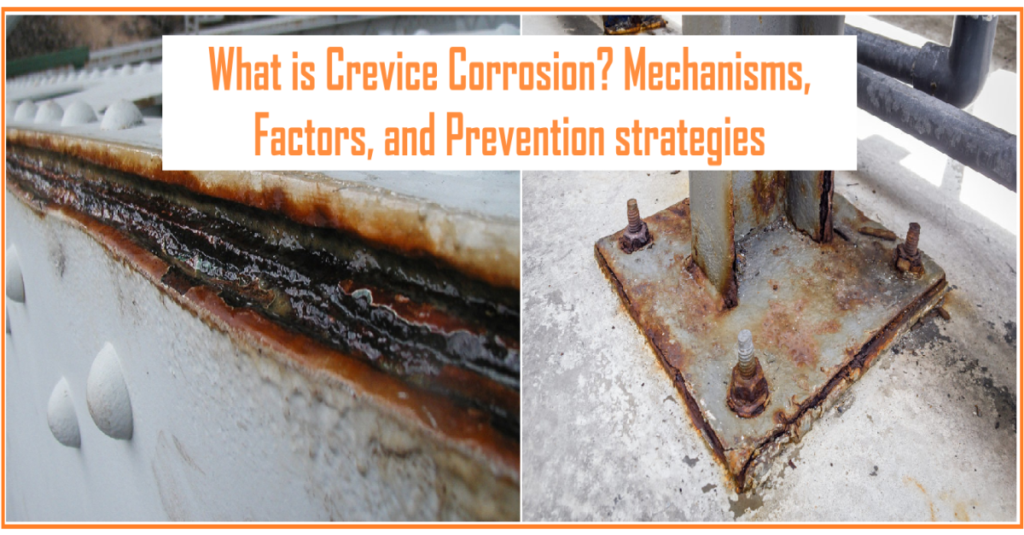Crevice corrosion is a type of localized corrosion that occurs in narrow gaps or crevices between metal surfaces. Despite its deceptive appearance, crevice corrosion can pose a significant threat to the integrity of metal structures, leading to unexpected failures if left unchecked. This article delves into the mechanisms, factors, and mitigation strategies associated with crevice corrosion.
Below picture shows crevice corrosion, its mechanism, factors and prevention strategies.

Crevice Corrosion Technical Explanation.
Crevice corrosion takes place when corrosive material is trapped in the tight areas where the normal flow of the streams is not possible. It normally takes place in the grooves or cracks of width 1/8 inch wide or smaller, where the normal flow conditions cannot be developed.
Crevice corrosion is detrimental as the failure may occur without warning, due to the fact that it takes place on the locations which are almost impossible to inspect with the conventional on‐stream inspection techniques.
The sequence of the corrosion mechanism involves the usual oxidation process in the metal inside the crevice. This creates the metal oxide and the crevice is depleted of the trapped oxygen.
Initial Anodic reaction inside crevice: Oxidation M → M+ + e–
Initial Cathodic Reaction inside Crevice: Reduction O2 + 2H2O + 4e– → 4OH-1
As the oxygen is depleted no more reduction reaction takes place inside the crevice, rather it takes place in the open area close to the crevice. Further creation of the metal ions unbalances the charge distribution inside the crevice and more positively charged metal ions are generated.
This charge imbalance attracts the chloride Cl-1 and OH-1 ions from outside the crevice. Due to stagnant situations lesser OH-1 ions migrate into the crevice as compared to smaller and more mobile chloride ions.
The charge imbalance inside is neutralized by the creation of Metal chlorides inside the crevice. The metal chlorides than readily hydrolyze inside the crevice and generate the H+1 (acid ions).
Metal Chloride Hydrolysis Reaction M+ + Cl-1 + H2O → MOH ↓ + H+1 + Cl-1
The H+1 ions considerably reduces the pH inside the crevice causing aggressive HCl corrosion.
Crevice corrosion is equally effective for carbon steel and corrosion resistant grades of steel (such as stainless steel). For the corrosion resistant alloys the resistance comes from the Passive (corrosion resistant) films which are developed on the surface, however these films are very unstable in presence of high concentrations of H+1 and Cl-1 ions.
Most vulnerable locations for Crevice corrosion are Gaskets area of the flanged joints lap weld joints, tight areas between shell and liner (in case of incomplete liner welding), delaminated surface overlays, and metal to bolt heads or rivet heads crevice, Nut and bolt threads, etc.
Mechanism of Crevice Corrosion.
Crevice corrosion initiates in confined spaces where stagnant or restricted access to oxygen and other environmental factors occurs. The crevice creates a microenvironment conducive to corrosion, often leading to accelerated degradation compared to the surrounding metal surface.
The process typically involves the following steps:
- Formation of Crevice: Crevice corrosion occurs in areas where two metal surfaces are in close proximity, such as joints, bolted connections, or beneath deposits or gaskets.
- Localized Chemical Environment: Within the crevice, stagnant or trapped electrolytes may form, creating a corrosive environment. These electrolytes may contain chlorides, sulfides, or other aggressive ions that promote corrosion.
- Differential Oxygen Concentration: Oxygen depletion within the crevice, coupled with the presence of aggressive ions, sets up an electrochemical gradient, establishing conditions favorable for corrosion.
- Anodic and Cathodic Reactions: Metal dissolution (anodic reaction) occurs at the exposed metal surfaces within the crevice, while reduction reactions (cathodic reactions) may occur elsewhere within the crevice or on the external metal surface.
- Pitting and Undercutting: Corrosion progresses locally, leading to the formation of pits, fissures, or undercutting beneath deposits or corrosion products. Over time, this can weaken the metal structure, potentially leading to structural failure.
Factors Influencing Crevice Corrosion.
Several factors influence the likelihood and severity of crevice corrosion:
- Environmental Conditions: Crevice corrosion is prevalent in environments with high chloride concentrations, such as marine environments, industrial settings, or areas exposed to salt-laden atmospheres.
- Material Composition: Certain metals and alloys are more susceptible to crevice corrosion than others. For example, stainless steels, aluminum alloys, and titanium alloys are particularly prone to crevice corrosion under certain conditions.
- Geometry and Design: The geometry of the crevice, including its width, depth, and accessibility to electrolytes, plays a crucial role in determining the susceptibility to crevice corrosion. Sharp corners, tight clearances, and areas prone to fluid stagnation are more susceptible.
- Temperature and pH: Elevated temperatures and acidic or alkaline pH levels can exacerbate crevice corrosion by accelerating chemical reactions and promoting aggressive ion dissolution.
Prevention Strategies.
Preventing crevice corrosion requires a combination of design, material selection, and maintenance strategies:
- Optimized Design: Minimize crevice formation by designing structures with smooth, accessible surfaces and avoiding sharp corners or tight clearances.
- Material Selection: Choose corrosion-resistant materials or alloys that are less susceptible to crevice corrosion in the intended operating environment.
- Surface Protection: Apply protective coatings, inhibitors, or sealants to vulnerable surfaces to create a barrier against corrosive agents.
- Proper Maintenance: Regular inspection and cleaning of crevices, removal of deposits, and monitoring of environmental conditions can help prevent crevice corrosion initiation and progression.
Crevice corrosion represents a hidden yet severe threat to metal structures, capable of causing localized damage and compromising structural integrity. By understanding the mechanisms, factors, and mitigation strategies associated with crevice corrosion, engineers and industry professionals can effectively safeguard against its detrimental effects, ensuring the long-term reliability and performance of metal components and assemblies in diverse applications.